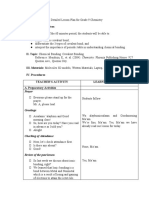The Particle Nature of Matter
The Particle Nature of Matter
Uploaded by
John Van Dave TaturoCopyright:
Available Formats
The Particle Nature of Matter
The Particle Nature of Matter
Uploaded by
John Van Dave TaturoOriginal Title
Copyright
Available Formats
Share this document
Did you find this document useful?
Is this content inappropriate?
Copyright:
Available Formats
The Particle Nature of Matter
The Particle Nature of Matter
Uploaded by
John Van Dave TaturoCopyright:
Available Formats
THE PARTICLE NATURE OF MATTER
These characteristics that describe a sample of matter are called properties
You measured the mass of each sample of matter using a balance or a weighing scale.
The mass of an object is a measure of the amount of matter the object has.
The measure of the space occupied by an object is called volume.
There are other properties of matter such as hardness, texture, color, flexibility, malleability, and
electrical conductivity which vary from one sample to another.
Almost 2,500 years ago, Leucippus and his disciple, Democritus believed that nature consisted of two
things, “atoms and the void that surrounds them” (Knieram, 1995-2013)
Democritus, atoms are indestructible and completely full, so there is no empty space.
atomos, a Greek word which means indivisible particle.
John Dalton presented concrete evidence that all matter is made of very small particles called atoms.
An atom is the smallest particle of an element that has all the properties of the element.
A molecule is a particle consisting of two or more atoms combined together in a specific arrangement.
The size of an atom is measured in angstroms. One angstrom is a unit of length equal to one ten
millionth of a millimetre.
The scanning tunneling microscope (STM) allows scientists to view and scan the surface of very small
particles like atoms.
Pointillism is a method of painting using dots to come up with various effects. The dots are placed singly,
in rows, or randomly.
models, which are drawings or diagrams that are representations of what is happening at a level beyond
what your eyes can see.
This is what science educators call the sub-microscopic model of representing an idea or concept, which
you cannot observe with your senses or even aided by a simple microscope.
Matter shows that in gases, the particles move at random directions very quickly and travel in straight-
line paths.
Gases take the shape of the container because the particles are able to move freely to all parts of the
container.
In liquids, the particles are closer to one another, nudging one another as they move.
Solids have definite shapes and volume because the particles are packed closely together in fixed
positions.
The process by which the molecules on the surface of a liquid break away and change into gas is called
evaporation.
This process where a gas is changed into a liquid is called condensation. It is the reverse of evaporation.
More molecules therefore have the energy to overcome the forces of attraction of the adjacent
molecules. These molecules escape to the gaseous phase. This is evaporation.
The molecules that escape from the liquid and go into the gaseous phase is called vapor
When a gas is cooled, the motion of the particles slows down. If the particles lose enough energy, their
attraction for each other can overcome their motion and cause them to associate with one another to
become a liquid. This process is called condensation.
This transformation process in which a solid is changed to a liquid is called melting.
Freezing is the process in which a liquid is changed to a solid.
ATOMS: INSIDE OUT
J.J. Thomson was able to discover that atoms have negatively-charged particles, which he called
electrons. It led him to propose a new model for the atom, which he called the plum pudding model.
Since plums and puddings are not commonly known in the Philippines, it may work better for you that
we use the other name for the model, the raisin bread model.
A group of scientists composed of Ernest Rutherford, Johannes "Hans" Wilhelm Geiger and Ernest
Marsden tested Thomson’s model by bombarding a very thin sheet of gold foil with positively-charged
alpha particles. Their experiment is referred to as the alpha particle scattering experiment.
Similarly, the way the alpha particles “bumped”, or did not “bump”, the particles in the atoms of
the gold foil led Rutherford’s team to propose another model for the atom, the nuclear model.
All atoms of an element contain the same number of protons in their nuclei. This number is the
element’s atomic number.
Atoms having the same number of protons but different number of neutrons are referred as
isotopes.
The isotopes are identified through their mass number which is the sum of the number of
protons and the number of neutrons in an atom. A shorthand notation for isotope includes the
element’s symbol and mass number
PERIODIC TABLE OF ELEMENTS
in 1817 to the work of Johann Dobereiner, a German chemist who formed the triads of elements
with similar properties like the triad of calcium, barium and strontium.
In 1863, John Newlands, an English chemist proposed the Law of Octaves. He based his
classification of elements on the fact that similar properties could be noted for every eight
element when they are arranged in order of increasing atomic masses.
Lothar Meyer and Dmitri Mendeleev both came up with periodic tables that showed how
elements should be grouped.
in 1914, Henry Moseley, an English physicist observed that the order of the X-ray frequencies
emitted by elements follows the ordering of the elements by atomic number.
periodic law which states that the properties of elements vary periodically with atomic number.
The vertical columns of the periodic table, called groups, identify the principal families of
elements.
You might also like
- 795B Master (v9)Document40 pages795B Master (v9)Rodrigo Bravo Rodrigo BravoNo ratings yet
- 3e68 PDFDocument76 pages3e68 PDFcharan hsNo ratings yet
- Atoms Lesson 1Document3 pagesAtoms Lesson 1Lornajane AlturaNo ratings yet
- Critical Content - Grade 8 - PeriodicTable - Final As of April 19, 2018Document176 pagesCritical Content - Grade 8 - PeriodicTable - Final As of April 19, 2018Judarlyn MadriaNo ratings yet
- Le3sso Guide 1 Module Plan First Quarter Biology PDFDocument29 pagesLe3sso Guide 1 Module Plan First Quarter Biology PDFconstancia G, caraan100% (1)
- Science Grade 9 Q2 LPDocument155 pagesScience Grade 9 Q2 LPChenee Bulawan PontilloNo ratings yet
- Atomic ModelDocument3 pagesAtomic ModelRONALD ARTILLERONo ratings yet
- DLP On Covalent BondDocument4 pagesDLP On Covalent BondHI M MANo ratings yet
- Lecture Activity No. 3 Molecules of Plant Life ChekedDocument13 pagesLecture Activity No. 3 Molecules of Plant Life ChekedMatthew Reyes Remegia100% (1)
- Mendelian GeneticsDocument26 pagesMendelian GeneticsLuisa SantosNo ratings yet
- Detailed Science Lesson Plan: Grade Level Quarter/Domain Week & Day No. Page NoDocument5 pagesDetailed Science Lesson Plan: Grade Level Quarter/Domain Week & Day No. Page NoCharlie CanarejoNo ratings yet
- Topic:: Bixby Knolls Preparatory Academy - San Antonio, QuezonDocument4 pagesTopic:: Bixby Knolls Preparatory Academy - San Antonio, QuezonTeacher OliNo ratings yet
- Lesson Plan 2020-2021Document7 pagesLesson Plan 2020-2021MELIE BAGARESNo ratings yet
- Co#1 IsotopesDocument13 pagesCo#1 IsotopesJodee Joy BigayNo ratings yet
- Atomic Review PacketDocument7 pagesAtomic Review Packetrjardon100% (1)
- Radioactivity 5 LessonsDocument6 pagesRadioactivity 5 LessonsHLSSummerInstituteNo ratings yet
- Chemical Reaction DLPDocument22 pagesChemical Reaction DLPLeslie MermeloNo ratings yet
- Riessa Jane Cañete's LPDocument4 pagesRiessa Jane Cañete's LPRjane CañeteNo ratings yet
- Detailed Science Lesson Plan: The Identity of A Substance According To Its Atomic StructureDocument4 pagesDetailed Science Lesson Plan: The Identity of A Substance According To Its Atomic StructureJennifer LinagaNo ratings yet
- Electronic Structure of MatterDocument21 pagesElectronic Structure of MatterRosé ParkNo ratings yet
- Lesson Plan Protista FixDocument13 pagesLesson Plan Protista FixRichard Tañada RosalesNo ratings yet
- Week 5 I. ObjectivesDocument6 pagesWeek 5 I. ObjectivesRhissan Bongalosa AcebucheNo ratings yet
- Elements Crossword Puzzle: Name: - Date: - PeriodDocument1 pageElements Crossword Puzzle: Name: - Date: - PeriodAlexa SolisNo ratings yet
- Lesson Exemplar in Science 8 Week 3Document6 pagesLesson Exemplar in Science 8 Week 3Joyce PerezNo ratings yet
- Formation of Ions LivestreamingDocument26 pagesFormation of Ions LivestreamingGregson GucelaNo ratings yet
- Detailed Lesson Plan in Science 8: ProceduresDocument8 pagesDetailed Lesson Plan in Science 8: ProceduresMc Laurence Marquez SaligumbaNo ratings yet
- Assignment 4 Lesson PlanDocument8 pagesAssignment 4 Lesson PlanGen Li TogyNo ratings yet
- Insect Lesson PlanDocument4 pagesInsect Lesson Planapi-300499627No ratings yet
- Adam Lesson Plan 1Document7 pagesAdam Lesson Plan 1api-257142724No ratings yet
- Monday Tuesday Wednesday Thursday FridayDocument7 pagesMonday Tuesday Wednesday Thursday FridayKen Mitchell MoralesNo ratings yet
- Chemistry - WEEK 3 - Module 12Document7 pagesChemistry - WEEK 3 - Module 12EZRA THERESE DE JESUS100% (1)
- DLP Quantum Model of The AtomsDocument14 pagesDLP Quantum Model of The AtomsDaniah AllemaNo ratings yet
- DLL Teenage PregnancyDocument5 pagesDLL Teenage PregnancyCharo Nudo PongasiNo ratings yet
- TOS GRADE 8 3rd GRADINGDocument1 pageTOS GRADE 8 3rd GRADINGMELISSA MORENONo ratings yet
- DLL Week 2 G 9 Science 22-23 Q2Document36 pagesDLL Week 2 G 9 Science 22-23 Q2Lady MayugaNo ratings yet
- 7 Elements in The Human BodyDocument2 pages7 Elements in The Human BodyCris CorsinoNo ratings yet
- DLL chemNOV15Document5 pagesDLL chemNOV15Rosallie Caaya-NuezNo ratings yet
- Lesson Plan in Science8 Sy 2015Document43 pagesLesson Plan in Science8 Sy 2015Noel PiedadNo ratings yet
- Electronic Structure and PeriodicityDocument36 pagesElectronic Structure and PeriodicityPADILLA Elaijalyn A.No ratings yet
- Science: Quarter 3 - Module 4Document23 pagesScience: Quarter 3 - Module 4MA EDYLYN NOGUERRANo ratings yet
- 5e Lesson - Dagne Beza-Protein SynthesisDocument5 pages5e Lesson - Dagne Beza-Protein Synthesisapi-528044846No ratings yet
- Lesson Plan PhysicsIA Kinematics Graphical Analysis of Motion 2008 Term1Document2 pagesLesson Plan PhysicsIA Kinematics Graphical Analysis of Motion 2008 Term1anon-794481No ratings yet
- L 7-8 Periodic Variations in Atomic PropertiesDocument15 pagesL 7-8 Periodic Variations in Atomic PropertiesアゼロスレイゼルNo ratings yet
- Chapter 3 Simple Bonding TheoryDocument133 pagesChapter 3 Simple Bonding TheorypuppyNo ratings yet
- Phase ChangeDocument24 pagesPhase ChangeChynna Andrea D. BelmonteNo ratings yet
- Electronic ConfigurationDocument4 pagesElectronic ConfigurationkarlNo ratings yet
- S7 - Q3 - Week 7Document9 pagesS7 - Q3 - Week 7gazelle grapes S. RonquilloNo ratings yet
- Topic 4 BondingDocument13 pagesTopic 4 Bondinglobna masadehNo ratings yet
- 4.3 Electric Circuits & Electrical SafetyDocument10 pages4.3 Electric Circuits & Electrical SafetyAyana AkjolovaNo ratings yet
- Activity Boyle's LawDocument1 pageActivity Boyle's LawmikaNo ratings yet
- DLP - Grade 8 Genetics-InertiansDocument2 pagesDLP - Grade 8 Genetics-InertiansKATHRYN CENTINALESNo ratings yet
- Detailed Lesson Plan in Science 8: P - OT - N N - TRO - N - LE - TR - NDocument8 pagesDetailed Lesson Plan in Science 8: P - OT - N N - TRO - N - LE - TR - NMc Laurence Marquez SaligumbaNo ratings yet
- LESSON PLAN-2-Covalent BondingDocument2 pagesLESSON PLAN-2-Covalent BondingHOWARD ZULUNo ratings yet
- Ions and Bonds PowerpointDocument26 pagesIons and Bonds Powerpointapi-2622192730% (1)
- Judy Lesson Plan Grade 8Document6 pagesJudy Lesson Plan Grade 8Judy IntervencionNo ratings yet
- Lesson Plan Class 11 July, 2019Document1 pageLesson Plan Class 11 July, 2019vimlesh kumarNo ratings yet
- Grade 10 Daily Lesson Plan Pasay City North High School-Tramo Campus Grade 10 ScienceDocument5 pagesGrade 10 Daily Lesson Plan Pasay City North High School-Tramo Campus Grade 10 ScienceEricha SolomonNo ratings yet
- Matulatula High School: Multiple Choice DIRECTIONS: Choose The Letter of The Correct Answer. EncircleDocument2 pagesMatulatula High School: Multiple Choice DIRECTIONS: Choose The Letter of The Correct Answer. EncircleANDJELYN M. ABALOSNo ratings yet
- Worksheet MomentumDocument5 pagesWorksheet MomentumSiti RohmahNo ratings yet
- 3rd Grading Exam ScienceDocument4 pages3rd Grading Exam ScienceRussel OchoNo ratings yet
- Chem03 IonicBondsv3Document8 pagesChem03 IonicBondsv3Charlie JohanningmeierNo ratings yet
- Material Chapter OneDocument13 pagesMaterial Chapter OneTeshale AlemieNo ratings yet
- Table-Of-specifications (Tos Diagnostic) 2022-2023Document1 pageTable-Of-specifications (Tos Diagnostic) 2022-2023John Van Dave TaturoNo ratings yet
- The Concept of Community: Prepared By: April Joy F. Bolodo, LPTDocument25 pagesThe Concept of Community: Prepared By: April Joy F. Bolodo, LPTJohn Van Dave TaturoNo ratings yet
- Action Plan ScideptDocument7 pagesAction Plan ScideptJohn Van Dave TaturoNo ratings yet
- Earth's MechanismDocument22 pagesEarth's MechanismJohn Van Dave Taturo100% (4)
- Feminist Literary CriticismDocument62 pagesFeminist Literary CriticismJohn Van Dave Taturo100% (1)
- ScienceDocument11 pagesScienceJohn Van Dave TaturoNo ratings yet
- UNIT 3: Computer Usage For Nurse Informaticists Chapter 4: Introduction To Software (Week 6) Intended Learning Outcomes (ILO)Document28 pagesUNIT 3: Computer Usage For Nurse Informaticists Chapter 4: Introduction To Software (Week 6) Intended Learning Outcomes (ILO)John Van Dave TaturoNo ratings yet
- Chapter 3: Role of Informatics Nurse Specialist (Week 4) Intended Learning Outcomes (ILO)Document10 pagesChapter 3: Role of Informatics Nurse Specialist (Week 4) Intended Learning Outcomes (ILO)John Van Dave TaturoNo ratings yet
- Group 2 YakalDocument9 pagesGroup 2 YakalJohn Van Dave TaturoNo ratings yet
- Medical EthicsDocument58 pagesMedical EthicsJohn Van Dave TaturoNo ratings yet
- Aspect of GlobalizationDocument7 pagesAspect of GlobalizationJohn Van Dave TaturoNo ratings yet
- Unit 1 - Week (1) - Comprehensive Assessment: Intended Learning Outcomes (Week 1-ILO)Document28 pagesUnit 1 - Week (1) - Comprehensive Assessment: Intended Learning Outcomes (Week 1-ILO)John Van Dave TaturoNo ratings yet
- NCM 114 Midterm Module ContentDocument54 pagesNCM 114 Midterm Module ContentJohn Van Dave TaturoNo ratings yet
- Communit Y Immersion: Prepared By: April Joy F. Bolodo, LPTDocument26 pagesCommunit Y Immersion: Prepared By: April Joy F. Bolodo, LPTJohn Van Dave TaturoNo ratings yet
- Learning Module in NCM 114 Pre FinalDocument77 pagesLearning Module in NCM 114 Pre FinalJohn Van Dave TaturoNo ratings yet
- Learning Module in NCM 114 FinalDocument101 pagesLearning Module in NCM 114 FinalJohn Van Dave Taturo100% (1)
- NI Module Powered by ARS Chapter 1 2Document10 pagesNI Module Powered by ARS Chapter 1 2John Van Dave TaturoNo ratings yet
- Intended Learning Outcomes: Unit 1: Implementing GuidelinesDocument13 pagesIntended Learning Outcomes: Unit 1: Implementing GuidelinesJohn Van Dave TaturoNo ratings yet
- NCM 114 Unit 1 To 4 GeriaDocument85 pagesNCM 114 Unit 1 To 4 GeriaJohn Van Dave Taturo100% (1)
- Nursing Care OF A Family Experiencing A Pregnancy From A Preexisting OR Newly Acquired IllnessDocument55 pagesNursing Care OF A Family Experiencing A Pregnancy From A Preexisting OR Newly Acquired IllnessJohn Van Dave TaturoNo ratings yet
- Evaluation Form Salida Talks Fire Prevention MonthDocument1 pageEvaluation Form Salida Talks Fire Prevention MonthJohn Van Dave TaturoNo ratings yet
- Module 3 ReviDocument35 pagesModule 3 ReviJohn Van Dave TaturoNo ratings yet
- Screening and Diagnostic Test For Chromosomal DisordersDocument21 pagesScreening and Diagnostic Test For Chromosomal DisordersJohn Van Dave TaturoNo ratings yet
- Intellectual Revolution: Science Technology and SocietyDocument19 pagesIntellectual Revolution: Science Technology and SocietyJohn Van Dave Taturo100% (1)
- STS Module Powered by ARS CHAPTER 1Document15 pagesSTS Module Powered by ARS CHAPTER 1John Van Dave Taturo100% (1)
- Complication of Pregnancy: By: Heidi Cutler CabanatanDocument53 pagesComplication of Pregnancy: By: Heidi Cutler CabanatanJohn Van Dave TaturoNo ratings yet
- Learning Module in Physical Education 4 SportsDocument31 pagesLearning Module in Physical Education 4 SportsJohn Van Dave Taturo0% (1)
- Bee Lab ManualDocument69 pagesBee Lab ManualYash AryaNo ratings yet
- Maipu MannualDocument12 pagesMaipu MannualKazi BarakatNo ratings yet
- Consent Online SurveyDocument2 pagesConsent Online Surveyapi-239920772No ratings yet
- Section 14.1 Functions of Several VariablesDocument6 pagesSection 14.1 Functions of Several VariablesAlvin AdityaNo ratings yet
- Chaliyama Steel Plant-Rungta Mines Limited Hazard Identification & Risk AssessmentDocument4 pagesChaliyama Steel Plant-Rungta Mines Limited Hazard Identification & Risk AssessmentCPP EI DSpNo ratings yet
- Catalog ErowaDocument46 pagesCatalog ErowafrdrfdederNo ratings yet
- NBU6Document24 pagesNBU6krsnagnaniNo ratings yet
- Rabang ThesisDocument90 pagesRabang ThesisSushmitha NagarajanNo ratings yet
- Hajj, Journey To The Heart of Islam PDFDocument273 pagesHajj, Journey To The Heart of Islam PDFPddfNo ratings yet
- 7TV 2 PFDocument111 pages7TV 2 PFFerg Hadley100% (1)
- Bussiness ManagementDocument3 pagesBussiness ManagementJanendra Gupta80% (5)
- Berthelot 1990Document18 pagesBerthelot 1990Matta SeshadriNo ratings yet
- Anosha NangrajDocument5 pagesAnosha NangrajAnoshaNo ratings yet
- Pipe Friction CalculationDocument22 pagesPipe Friction CalculationHosamMohamedNo ratings yet
- Nits AND Easurement: Hapter WODocument23 pagesNits AND Easurement: Hapter WOFelipeNo ratings yet
- Heat Pump Energen Air-WaterDocument2 pagesHeat Pump Energen Air-WaterVinay Tunge0% (1)
- Silencers: Dissipative (Or Absorptive) Reactive SilencersDocument6 pagesSilencers: Dissipative (Or Absorptive) Reactive SilencersShiva KrishnanNo ratings yet
- Have Been & Has Been & Had Been Example / ExercisesDocument3 pagesHave Been & Has Been & Had Been Example / ExercisesDecent ProductsNo ratings yet
- Magnetic Effect of Current (Practice Questions)Document7 pagesMagnetic Effect of Current (Practice Questions)Somnath BanerjeeNo ratings yet
- 170 Cau Dang Chia Dong Tu Trong Tieng AnhDocument6 pages170 Cau Dang Chia Dong Tu Trong Tieng AnhLalisa ManobalNo ratings yet
- Backup Exec Interview QuestionDocument5 pagesBackup Exec Interview QuestionmailforasifNo ratings yet
- Pca SPSSDocument52 pagesPca SPSSDina Tauhida100% (1)
- Dispersant TechnologyDocument2 pagesDispersant TechnologyMajd M. KhalilNo ratings yet
- Instructions For Use: Index Installation 4Document26 pagesInstructions For Use: Index Installation 4edgarNo ratings yet
- Peterson Practice Test 2 SatDocument46 pagesPeterson Practice Test 2 SatAiko EugeniaNo ratings yet
- Birds of KuwaitDocument418 pagesBirds of KuwaitHarsh Tiwari80% (5)
- Canada The Story of Us Episode 6 Discussion QuestionsDocument2 pagesCanada The Story of Us Episode 6 Discussion Questionsapi-673173331No ratings yet
- MankoffDocument14 pagesMankoffMariam KipianiNo ratings yet




















































































































